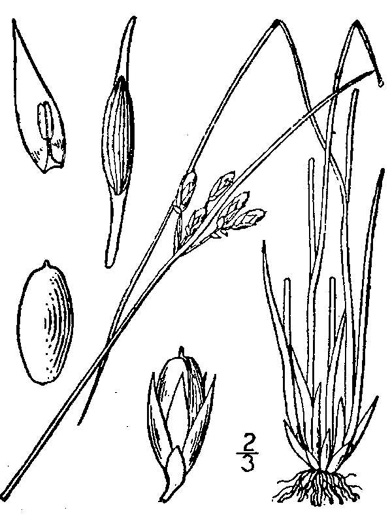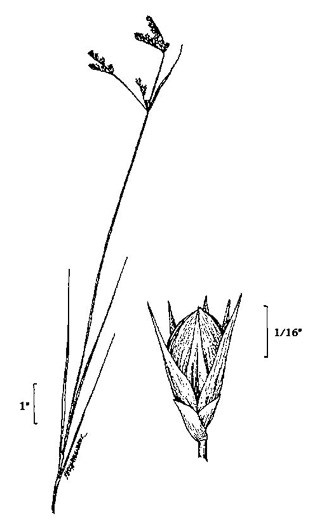Spermatophytes (seed plants): Angiosperms (flowering plants): Monocots: Commelinids: Poales
WEAKLEY'S FLORA OF THE SOUTHEASTERN US (4/24/22):
Juncus secundus
FAMILY
Juncaceae
Go to FSUS key
Dig deeper at SERNEC, a consortium of southeastern herbaria.
This is a rare case of non-wetland species of Juncus - usually in thin soil over a flat rock surface. Lopsided Rush is very similar to the ubiquitous Path Rush (J. tenuis), but the lowest involucral leaf is shorter than the inflorescence and the leaf sheath auricle is very short (vs. prolonged). Read more at Vascular Plants of North Carolina.
SYNONYMOUS WITH
PLANTS NATIONAL DATABASE:
Juncus secundus
FAMILY
Juncaceae
SYNONYMOUS WITH Flora of North America
Juncus secundus
SYNONYMOUS WITH VASCULAR FLORA OF THE CAROLINAS (Radford, Ahles, & Bell, 1968) 040-01-009:
Juncus secundus FAMILY Juncaceae
SYNONYMOUS WITH Manual of the Southeastern Flora (Small, 1933, 1938)
Juncus secundus
COMMON NAME:
Lopsided Rush, Secund Rush
To see larger pictures, click or hover over the thumbnails.
WEAKLEY'S FLORA OF THE SOUTHEASTERN US (4/24/22):
Juncus secundus
FAMILY
Juncaceae
SYNONYMOUS WITH
PLANTS NATIONAL DATABASE:
Juncus secundus
FAMILY
Juncaceae
SYNONYMOUS WITH
Flora of North America
Juncus secundus
SYNONYMOUS WITH
VASCULAR FLORA OF THE CAROLINAS (Radford, Ahles, & Bell, 1968) 040-01-009:
Juncus secundus
FAMILY
Juncaceae
SYNONYMOUS WITH
Manual of the Southeastern Flora (Small, 1933, 1938)
Juncus secundus
If a search such as "Carex leptalea var. leptalea" doesn't deliver the results you want, try "Carex leptalea".
Or, to minimize chances of a misspelling, try just "Carex le".
Less is more: If "pencil flower" doesn't deliver the results you want, try "pencil".



